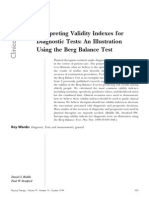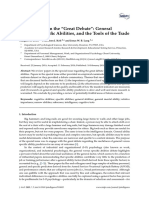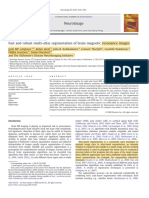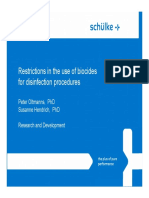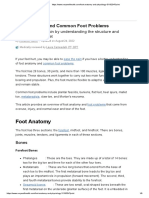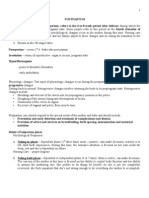0 ratings0% found this document useful (0 votes)
94 viewsManual Therapy: Letter To The Editor
Manual Therapy: Letter To The Editor
Uploaded by
ubiktrash1492Clinimetric analysis of a German version of the Neck Disability Index (NDI-G) was not emphasized in the abstract or conclusion. Determination of stable point estimates with the study's small sample are exceedingly difficult. Factor structure guarantees validity in the presence of high item diversity. Factor analysis is initially exploratory and ideally uses orthogonal rotation, a minimumsubject:item ratio of 20:1 to ensure strong factor structures are replicated reliably
Copyright:
© All Rights Reserved
Available Formats
Download as PDF, TXT or read online from Scribd
Manual Therapy: Letter To The Editor
Manual Therapy: Letter To The Editor
Uploaded by
ubiktrash14920 ratings0% found this document useful (0 votes)
94 views2 pagesClinimetric analysis of a German version of the Neck Disability Index (NDI-G) was not emphasized in the abstract or conclusion. Determination of stable point estimates with the study's small sample are exceedingly difficult. Factor structure guarantees validity in the presence of high item diversity. Factor analysis is initially exploratory and ideally uses orthogonal rotation, a minimumsubject:item ratio of 20:1 to ensure strong factor structures are replicated reliably
Original Title
1-s2.0-S1356689X13001872-main.pdf
Copyright
© © All Rights Reserved
Available Formats
PDF, TXT or read online from Scribd
Share this document
Did you find this document useful?
Is this content inappropriate?
Clinimetric analysis of a German version of the Neck Disability Index (NDI-G) was not emphasized in the abstract or conclusion. Determination of stable point estimates with the study's small sample are exceedingly difficult. Factor structure guarantees validity in the presence of high item diversity. Factor analysis is initially exploratory and ideally uses orthogonal rotation, a minimumsubject:item ratio of 20:1 to ensure strong factor structures are replicated reliably
Copyright:
© All Rights Reserved
Available Formats
Download as PDF, TXT or read online from Scribd
Download as pdf or txt
0 ratings0% found this document useful (0 votes)
94 views2 pagesManual Therapy: Letter To The Editor
Manual Therapy: Letter To The Editor
Uploaded by
ubiktrash1492Clinimetric analysis of a German version of the Neck Disability Index (NDI-G) was not emphasized in the abstract or conclusion. Determination of stable point estimates with the study's small sample are exceedingly difficult. Factor structure guarantees validity in the presence of high item diversity. Factor analysis is initially exploratory and ideally uses orthogonal rotation, a minimumsubject:item ratio of 20:1 to ensure strong factor structures are replicated reliably
Copyright:
© All Rights Reserved
Available Formats
Download as PDF, TXT or read online from Scribd
Download as pdf or txt
You are on page 1of 2
Letter to the Editor
Commentary on the article by Swanenburg et al. Validity and reliability
of a German version of the Neck Disability Index (NDI-G) [Man Ther
Articles in Press http://dx.doi.org/10.1016/j.math.2013.07.004]
Keywords:
Outcome measure
Clinimetrics
Cervical spine
Neck Disability Index
Dear Editor
We commend Swanenburg et al. (2013) on translation, develop-
ment, and clinimetric analysis of the NDI-G. However, the dual-
factor structure with factor analysis and the high level of internal
consistency (IC) highlighted in their discussion were not empha-
sized in the abstract or conclusion. These points may imply some
inconsistencies with the nal conclusions since determination of
stable point estimates with the studys small sample are exceed-
ingly difcult.
Patient-reported outcome (PRO) tools provide the research evi-
dence of an interventions effectiveness which can, subsequently,
inuence health management and decision makers on treatment,
policy, and recommendations for funding and service provisions
(Lamb et al., 2013). Consequently, it is critical to analyze the clini-
metric properties, to determine that they are within the accepted
boundaries, then reect on the implications of these ndings,
particularly when a cultural and linguistic adaptation has taken
place (Cuesta-Vargas and Gabel, 2013).
Factor structure guarantees validity in the presence of high item
diversity (Cattell, 1982). Dual-factors should be reported indepen-
dently (Doward and McKenna, 2004) as in recent papers support-
ing modications to the NDI (van der Velde et al., 2009; Johansen
et al., 2013; Walton and MacDermid, 2013) or alternatives (Gabel
et al., submitted for publication). A single factor is essential if a sin-
gle summated-score is used and ensures all items reect the same
domain (Luce and Tukey, 1964). Factor analysis is initially explor-
atory and ideally uses orthogonal rotation, a minimumsubject:item
ratio of 20:1 to ensure strong factor structures are replicated reli-
ably, and either maximum likelihood extraction or principal axis
factoring. These methods produce generalizable and reproducible
results without inating the variance estimates (Costello and
Osborne, 2005). The NDI-G study used principal component anal-
ysis, a common error by many researchers as principal component
analysis is less desirable and normally only used when assumptions
of multivariate normality are severely violated (Fabrigar et al.,
1999) as there are no inherent advantages over maximum likeli-
hood extraction or principal axis factoring. Subsequent, conrma-
tory factor analysis minimizes noise often present among PRO-
items in tools where IC is maximized (Boyle, 1991).
The authors found the IC coefcient-alpha (a) of 0.96 might be
a slight limitation as it exceeded the acceptable range . 0.75e
0.95 (Terwee et al., 2007) and scored above results from other
studies (Vernon, 2008). This consideration is important as IC
values outside this window question the measures validity.
Low IC indicates a lack of item-correlation, meaning analysis is
not justied, whereas high IC indicates item-redundancy, where
too many items are too similar (Boyle, 1991). The accepted IC win-
dow ensures the essential construct is represented and the com-
plex balance retained between the items and the laws of
psychometric analysis (Cattell, 1982). It is well-recognized that
misestimated alpha values are commonly due to small samples
and multi-factor measures assessed as a single factor, both present
in this study.
Clinimetrics are the foundation that underlies PRO-validity. This
study performed an analysis where the number of parameters esti-
mated is not much smaller than the sample size itself. Conse-
quently, there is limited expectation that an analysis such as this
would replicate. For both the conclusion and abstract, it may be
more appropriate to state that in addition to the recommendations
proposed, use of the NDI-G in German-speaking countries should
be guarded until further studies are completed that reassess and
clarify the clinimetric properties, particularly the factor structure,
in a larger population. This additional recommendation would be
more consistent with the study ndings and recent research on
the original NDI and proposed modied-NDI versions.
Yours sincerely
The authors state there is no conict of interest, including nan-
cial support related to the issue addressed.
References
Boyle GJ. Does item homogeneity indicate internal consistency or item redundancy
in psychometric scales? Personal Indiv Differ 1991;12(3):291e4.
Cattell RB. The psychometry of objective motivation measurement: a response to
the critique of Cooper and Kline. Br J Ed Psych 1982;52:234e41.
Costello AB, Osborne J. Best practices in exploratory factor analysis: four recom-
mendations for getting the most from your analysis. Pract Assess Res Eval
2005;10(7):1e9.
Cuesta-Vargas AI, Gabel CP. Cross-cultural adaptation, reliability and validity of the
Spanish version of the upper limb functional index. Health Qual Life Outcomes
2013;11(126).
Doward LC, McKenna SP. Dening patient-reported outcomes. Value Health
2004;7(S1):S4e8. DOI of original article: http://dx.doi.org/10.1016/j.math.2013.07.004.
Contents lists available at ScienceDirect
Manual Therapy
j ournal homepage: www. el sevi er. com/ mat h
Manual Therapy 19 (2014) e1ee2
1356-689X/$ e see front matter 2013 Elsevier Ltd. All rights reserved.
http://dx.doi.org/10.1016/j.math.2013.10.007
Fabrigar LR, Wegener DT, MacCallum RC, Strahan EJ. Evaluating the use of explor-
atory factor analysis in psychological research. Psychol Methods 1999;4(2):
272e99.
Gabel CP, Cuesta-Vargas AI, Osborne JO, Burkett B, Melloh M. Conrmatory factory
analysis of the Neck Disability Index indicates a one-factor model. Spine 2013,
(pii: S1529-9430(13)01473-3) in press.
Johansen JB, Andelic N, Bakke E, Holter EB, Mengshoel AM, Re C. Measurement
properties of the Norwegian version of the Neck Disability Index in chronic
neck pain. Spine (Phila Pa 1976) 2013;38(10):851e6.
Lamb SE, Gates S, Williams MA, Williamson EM, Mt-Isa S, Withers EJ, et al.; MINT.
Collaborators (91). Emergency department treatments and physiotherapy for
acute whiplash: a pragmatic, two-step, randomised controlled trial. Lancet
2013;381(9866):546e56.
Luce RD, Tukey JW. Simultaneous conjoint measurement: a new type of funda-
mental measurement. J Math Psychol 1964;1(1):1e27.
Swanenburg J, Humphreys K, Langenfeld A, Brunner F, Wirth B. Validity and reli-
ability of a German version of the Neck Disability Index (NDI-G). Man Ther
2013. Aug 3, pii: S1356-689X(13)00122-7, http://dx.doi.org/10.1016/j.math.
2013.07.004.
Terwee CB, Bot SD, de Boer MR, van der Windt DA, Knol DL, Dekker J, et al. Quality
criteria were proposed for measurement properties of health status question-
naires. J Clin Epidemiol 2007;60(1):34e42.
van der Velde G, Beaton D, Hogg-Johnston S, Hurwitz E, Tennant A. Rasch analysis
provides new insights into the measurement properties of the Neck Disability
Index. Arthritis Rheum 2009;61(4):544e51.
Vernon H. The Neck Disability Index: state-of-the-art, 1991e2008. J Manipulative
Physiol Ther 2008;31(7):491e502.
Walton DM, MacDermid JC. A brief 5-item version of the Neck Disability Index
shows good psychometric properties. Health Qual Life Outcomes
2013;11(108).
Charles Philip Gabel
*
Faculty of Science, Health and Education, Centre for Healthy Activities,
Sport and Exercise, University of the Sunshine Coast,
Queensland, Australia
Antonio Cuesta-Vargas
Department of Psychiatry and Physiotherapy,
Faculty of Medicine, Malaga University, Spain
E-mail address: acuesta@uma.es.
Jason W. Osborne
Educational and Counselling Psychology,
University of Louisville, Louisville, KY, USA
E-mail address: jason.osborne@louisville.edu.
Markus Melloh
Western Australian Institute for Medical Research (WAIMR),
University of Western Australia, Nedlands,
Western Australia, Australia
E-mail address: markus.melloh@uwa.edu.au.
*
Corresponding author. PO Box 760, Coolum Beach, Queensland
4573, Australia. Tel.: 61 7 5446 1022; fax: 61 7 5471 7022.
E-mail address: cp.gabel@bigpond.com (C.P. Gabel).
4 September 2013
Letter to the Editor / Manual Therapy 19 (2014) e1ee2 e2
You might also like
- Benton Judgment of Line OrientationDocument16 pagesBenton Judgment of Line OrientationbobbysingersyahooNo ratings yet
- Atlas of Osteopathic TechniquesDocument80 pagesAtlas of Osteopathic Techniquesubiktrash1492100% (2)
- Home Study Course in Osteopathy Massage and Manual Therapeutics 1900 PDFDocument150 pagesHome Study Course in Osteopathy Massage and Manual Therapeutics 1900 PDFubiktrash1492100% (2)
- Pathophysiology of TuberculosisDocument3 pagesPathophysiology of TuberculosisMonica Marie Morales87% (15)
- SanofiDocument46 pagesSanofiAbbas ZiaNo ratings yet
- Lesson Plan On Alternative System of MedicineDocument37 pagesLesson Plan On Alternative System of MedicineSagiraju Srinu100% (4)
- Zsido Etal Stai Short MsDocument24 pagesZsido Etal Stai Short MsTHAO LE VU THANHNo ratings yet
- Do You Feel Like I Do? A Study of Spontaneous and Deliberate Emotion Sharing and Understanding Between Artists and Perceivers of Installation ArtDocument17 pagesDo You Feel Like I Do? A Study of Spontaneous and Deliberate Emotion Sharing and Understanding Between Artists and Perceivers of Installation ArtJonathan NavasNo ratings yet
- Effect Size Confidence Interval and Statistical Significance Guide For BiologistsDocument15 pagesEffect Size Confidence Interval and Statistical Significance Guide For Biologistssal27adamNo ratings yet
- MODEL Critical Appraisal Assignment 2Document16 pagesMODEL Critical Appraisal Assignment 2alukoNo ratings yet
- Laterality: Asymmetries of Body, Brain and CognitionDocument11 pagesLaterality: Asymmetries of Body, Brain and CognitionMutia FatinNo ratings yet
- Bakker2019 Article BeyondSmallMediumOrLargePointsDocument8 pagesBakker2019 Article BeyondSmallMediumOrLargePointsDhian SintapertiwiNo ratings yet
- Adult Nursing Research ProjectDocument9 pagesAdult Nursing Research ProjectTracy KNo ratings yet
- Dodge Symposium MCI 2014 V7 LatestDocument34 pagesDodge Symposium MCI 2014 V7 LatestWorldEventsForumNo ratings yet
- Journal of Yoga and Physical TherapyDocument1 pageJournal of Yoga and Physical Therapykhadesakshi55No ratings yet
- TESOL Research GuidelinesDocument17 pagesTESOL Research GuidelinesGábor Szekeres100% (1)
- Manual Therapy: Anabela G. Silva, T. David Punt, Mark I. JohnsonDocument6 pagesManual Therapy: Anabela G. Silva, T. David Punt, Mark I. JohnsonOana RuxandraNo ratings yet
- Measurement Properties of Translated Versions of Neck-Specific Questionnaires: A Systematic ReviewDocument14 pagesMeasurement Properties of Translated Versions of Neck-Specific Questionnaires: A Systematic ReviewMeisyaNo ratings yet
- GCS Assessment ArticleDocument15 pagesGCS Assessment ArticleduniayanNo ratings yet
- Ej1179609 PDFDocument11 pagesEj1179609 PDFJuan Rocha DurandNo ratings yet
- To Adjust or Not Adjust Nonparametric Effect Sizes, Confidence Intervals, and Real-World Meaning PDFDocument7 pagesTo Adjust or Not Adjust Nonparametric Effect Sizes, Confidence Intervals, and Real-World Meaning PDFTodd MartinezNo ratings yet
- Outcome JebsenDocument4 pagesOutcome JebsenfervoglerNo ratings yet
- H Clinical Assessment ToolsDocument71 pagesH Clinical Assessment ToolsPaijo SusenoNo ratings yet
- A Non-Parametric Bayesian Diagnostic For Detecting Differential Item Functioning in IRT ModelsDocument17 pagesA Non-Parametric Bayesian Diagnostic For Detecting Differential Item Functioning in IRT ModelsFaza FathyaNo ratings yet
- Multidimensional Sense of Emptiness ScaleDocument24 pagesMultidimensional Sense of Emptiness Scalebilou1981.gbNo ratings yet
- McNeish - Wolf (Dynamic Fit) SCALEDDocument98 pagesMcNeish - Wolf (Dynamic Fit) SCALEDLuigii Jaimes AvilaNo ratings yet
- Meta-Analysis in Environmental Statistics: Vic HasselbladDocument26 pagesMeta-Analysis in Environmental Statistics: Vic HasselbladSuryaNo ratings yet
- Barthels Index of ADLs PDFDocument4 pagesBarthels Index of ADLs PDFWindaNo ratings yet
- A Meta Analysis of Behavioral Interventions for Adolescents and Adults with Autism Spectrum DisordersDocument29 pagesA Meta Analysis of Behavioral Interventions for Adolescents and Adults with Autism Spectrum DisordersGermano Sousa PazNo ratings yet
- Art DiezDocument14 pagesArt DiezANTONIO REYES MEDINANo ratings yet
- Osborne - Costello - SAMPLE SIZEDocument10 pagesOsborne - Costello - SAMPLE SIZEluzcopaja30111991No ratings yet
- Effect Size Estimates - Current Use, Calculation and InterpretationDocument18 pagesEffect Size Estimates - Current Use, Calculation and InterpretationEduardoNo ratings yet
- Verrryyy Important33Document11 pagesVerrryyy Important33Gizaw FulasNo ratings yet
- Fpsyg 11 01300Document11 pagesFpsyg 11 01300Hung TranNo ratings yet
- Power Analysis Working Group Supplement Aug 6 19Document42 pagesPower Analysis Working Group Supplement Aug 6 19Kakazumba99No ratings yet
- Running Head: Weighing The Evidence 1Document3 pagesRunning Head: Weighing The Evidence 1johnNo ratings yet
- Statistical Analysis of Air PollutionDocument39 pagesStatistical Analysis of Air PollutionpranavNo ratings yet
- 2003 Evaluating SngleCase Data Compare 7 Stat Methods Parker PDFDocument23 pages2003 Evaluating SngleCase Data Compare 7 Stat Methods Parker PDFAdina CarterNo ratings yet
- Lisa Research Critique finale REVISEDDocument18 pagesLisa Research Critique finale REVISEDDANTOZ CYBERNo ratings yet
- Test Retest Reliability of The Play or Pass Version of The 1r7e5h3a7jDocument15 pagesTest Retest Reliability of The Play or Pass Version of The 1r7e5h3a7jJoysri RoyNo ratings yet
- Larson 2016Document9 pagesLarson 2016Anderson GaldinoNo ratings yet
- The Fugl-Meyer Upper Extremity ScaleDocument2 pagesThe Fugl-Meyer Upper Extremity ScaleRosa M. AlcaláNo ratings yet
- Basic Biostatistics Syllabus MPH 2022-2024Document5 pagesBasic Biostatistics Syllabus MPH 2022-2024Dr. Arya AgarwalNo ratings yet
- Journal of Affective Disorders: Chia-Hsiung Cheng, Pei-Ying S. Chan, Chia-Yih Liu, Shih-Chieh HsuDocument5 pagesJournal of Affective Disorders: Chia-Hsiung Cheng, Pei-Ying S. Chan, Chia-Yih Liu, Shih-Chieh HsuFernanda0518No ratings yet
- Architectural Concept Paper On Psychological HospitalDocument6 pagesArchitectural Concept Paper On Psychological HospitalAlonamaeterceroNo ratings yet
- Interpreting Validity Indexes For Diagnostic TestsDocument10 pagesInterpreting Validity Indexes For Diagnostic TestsJudson BorgesNo ratings yet
- Dodge - Symposium MCI 2014 V5Document33 pagesDodge - Symposium MCI 2014 V5WorldEventsForumNo ratings yet
- RM DissertDocument3 pagesRM Dissertvidushee.pemNo ratings yet
- Scale Development ThesisDocument7 pagesScale Development Thesiskarennelsoncolumbia100% (2)
- Exploring The Role of Age As A Moderator of Cognitive Remediation SchizophreniaDocument7 pagesExploring The Role of Age As A Moderator of Cognitive Remediation SchizophreniammimcNo ratings yet
- Work Support, Psychological Well-Being and Safety Performance Among Nurses in Hong KongDocument7 pagesWork Support, Psychological Well-Being and Safety Performance Among Nurses in Hong KongAshleigh Joyz LamNo ratings yet
- Improving Representativeness of Survey ResponseDocument18 pagesImproving Representativeness of Survey ResponseAshish GuptaNo ratings yet
- RELEX An Excel-Based Software Tool For Sampling Split-Half Reliability CoefficientsDocument7 pagesRELEX An Excel-Based Software Tool For Sampling Split-Half Reliability CoefficientsqueengraciousNo ratings yet
- 5factor ModelDocument15 pages5factor ModelAlmeDina AganovicNo ratings yet
- AQ Italian Validation - Sommantico Et Al.Document24 pagesAQ Italian Validation - Sommantico Et Al.Lop MezNo ratings yet
- Molde Et Al. (2020)Document9 pagesMolde Et Al. (2020)gwjnnn6thzNo ratings yet
- Brain Is Related To BehaviorDocument10 pagesBrain Is Related To BehaviorLibardo Gomez LopezNo ratings yet
- Brain and Cognition: Erika Nyhus, Francisco BarcelóDocument15 pagesBrain and Cognition: Erika Nyhus, Francisco BarcelóJohn000123No ratings yet
- tmp153F TMPDocument3 pagestmp153F TMPFrontiers100% (1)
- Commenting On The Great Debate General Abilities SDocument11 pagesCommenting On The Great Debate General Abilities SucanNo ratings yet
- CI and Effect SizeDocument19 pagesCI and Effect Sizeshrestha.deepa2016No ratings yet
- Goldberg's IPIP Big Five Factor Markers Internal Consistency and Concurrent Validation in ScotlandDocument13 pagesGoldberg's IPIP Big Five Factor Markers Internal Consistency and Concurrent Validation in ScotlandZoran Rapaic100% (1)
- Fast and Robust Multi-Atlas Segmentation of Brain Magnetic Resonance ImageDocument14 pagesFast and Robust Multi-Atlas Segmentation of Brain Magnetic Resonance ImageDesirée López PalafoxNo ratings yet
- A Sorrow Shared Is A Sorrow Halved A Three-Arm Randomized Controlled Trial Comparing Internet-Based Clinician-Guided Individual Versus Group Treatment For Social Anxiety DisorderDocument45 pagesA Sorrow Shared Is A Sorrow Halved A Three-Arm Randomized Controlled Trial Comparing Internet-Based Clinician-Guided Individual Versus Group Treatment For Social Anxiety DisorderZhewen TangNo ratings yet
- Cholesterol e Book FinalDocument14 pagesCholesterol e Book Finalubiktrash1492No ratings yet
- Type of Bread: Important Information If You Have Type 2 DiabetesDocument1 pageType of Bread: Important Information If You Have Type 2 Diabetesubiktrash1492No ratings yet
- Cereal: Important Information If You Have Type 2 DiabetesDocument1 pageCereal: Important Information If You Have Type 2 Diabetesubiktrash1492No ratings yet
- 10+ Top Medical: Tests To Follow On The LCHF DietDocument12 pages10+ Top Medical: Tests To Follow On The LCHF Dietubiktrash1492No ratings yet
- Movilidad MadridDocument9 pagesMovilidad Madridubiktrash1492No ratings yet
- A Time To FastDocument7 pagesA Time To Fastubiktrash1492No ratings yet
- Dive Sites (Dive Spots) : TOYAPAKEH - Nusa PenidaDocument3 pagesDive Sites (Dive Spots) : TOYAPAKEH - Nusa Penidaubiktrash1492No ratings yet
- NIH Public Access: A High-Fiber Diet Does Not Protect Against Asymptomatic DiverticulosisDocument17 pagesNIH Public Access: A High-Fiber Diet Does Not Protect Against Asymptomatic Diverticulosisubiktrash1492No ratings yet
- Physical Inactivity: The Biggest Public Health Problem of The 21st CenturyDocument3 pagesPhysical Inactivity: The Biggest Public Health Problem of The 21st Centuryubiktrash1492No ratings yet
- Training Endurance Part1Document2 pagesTraining Endurance Part1ubiktrash1492No ratings yet
- Association of Dietary Fatty Acids With Coronary RiskDocument17 pagesAssociation of Dietary Fatty Acids With Coronary Riskubiktrash1492No ratings yet
- Manual TherapyDocument10 pagesManual Therapyubiktrash1492No ratings yet
- Training Endurance Part2Document2 pagesTraining Endurance Part2ubiktrash1492No ratings yet
- Training Endurance Part1Document2 pagesTraining Endurance Part1ubiktrash1492No ratings yet
- Principles of Osteopathy PDFDocument188 pagesPrinciples of Osteopathy PDFubiktrash14920% (1)
- Pre-Assessment and PAR-QDocument7 pagesPre-Assessment and PAR-QMaria VictoriaNo ratings yet
- Cavity Design Line Angle and Point Angle: Presented ByDocument93 pagesCavity Design Line Angle and Point Angle: Presented ByANUBHA100% (1)
- Maternity Benefit Act, 1961Document15 pagesMaternity Benefit Act, 1961Jyoti DaveNo ratings yet
- Human Genetic EngineeringDocument3 pagesHuman Genetic Engineeringbizabt100% (2)
- Coke Msds (Opal)Document6 pagesCoke Msds (Opal)Viral PatelNo ratings yet
- Ethiopian Public Procurement For Construction SectorDocument29 pagesEthiopian Public Procurement For Construction Sectortegbaru terefe57% (7)
- Fournier S GangreneDocument8 pagesFournier S GangreneabhishekbmcNo ratings yet
- Design Construction and Maintenance of A Biogas Generator PDFDocument23 pagesDesign Construction and Maintenance of A Biogas Generator PDFBiswa Jyoti GuptaNo ratings yet
- Mauli Fridge PODocument3 pagesMauli Fridge POdeepak_023No ratings yet
- Policy Brief: India and Sustainable Development Goals (SDGS)Document12 pagesPolicy Brief: India and Sustainable Development Goals (SDGS)Nishat SinghNo ratings yet
- Medicina 58 00620Document15 pagesMedicina 58 00620Percy Rojas EstebanNo ratings yet
- nRICH Article 31Document6 pagesnRICH Article 31sanjeev kumarNo ratings yet
- Carcass and Performance Characteristics of Broiler Chickens Fed With Cymbopogon Citratus Leaf Meal As Alternative To Mycotoxin BinderDocument6 pagesCarcass and Performance Characteristics of Broiler Chickens Fed With Cymbopogon Citratus Leaf Meal As Alternative To Mycotoxin BinderEduard MorenoNo ratings yet
- Approach To Fever in Opd PraciceDocument55 pagesApproach To Fever in Opd PraciceAbhijitNo ratings yet
- Oltmanns - Restrictions in The Use of Biocides For Disinfection ProceduresDocument25 pagesOltmanns - Restrictions in The Use of Biocides For Disinfection ProceduresDiptarghya KunduNo ratings yet
- Stoma CounselingDocument5 pagesStoma CounselingFitriana HermanNo ratings yet
- DocumentsDocument4 pagesDocumentsupsc.bengalNo ratings yet
- Uses of LipidsDocument3 pagesUses of LipidsChris Ian AgustinNo ratings yet
- Activity 4-Personal Vision StatementDocument4 pagesActivity 4-Personal Vision StatementAbenezer HailuNo ratings yet
- Summary Sheets: Carbohydrate Protein Vitamins Minerals Fibre Constipation) WaterDocument2 pagesSummary Sheets: Carbohydrate Protein Vitamins Minerals Fibre Constipation) WaterHelen100% (1)
- Foot Anatomy and PhysiologyDocument9 pagesFoot Anatomy and PhysiologyMarta BłaszczykNo ratings yet
- ANT325 Study Guide 5861Document20 pagesANT325 Study Guide 5861Iza AdnanNo ratings yet
- Wound Irrigation 21.Document18 pagesWound Irrigation 21.Juice Wrld 999No ratings yet
- MarriageDocument38 pagesMarriagedrkadiyala2No ratings yet
- PostpartumDocument15 pagesPostpartumdexter100% (16)
- Emulgent Blend SilylDocument6 pagesEmulgent Blend SilyldaantonirishmarieNo ratings yet
- (B) Evaluate The Characteristics, Types and Measures of Schizophrenia and Psychotic Disorders, Including A Discussion of Case StudiesDocument1 page(B) Evaluate The Characteristics, Types and Measures of Schizophrenia and Psychotic Disorders, Including A Discussion of Case StudiesHenry Nguyen PhamNo ratings yet













































